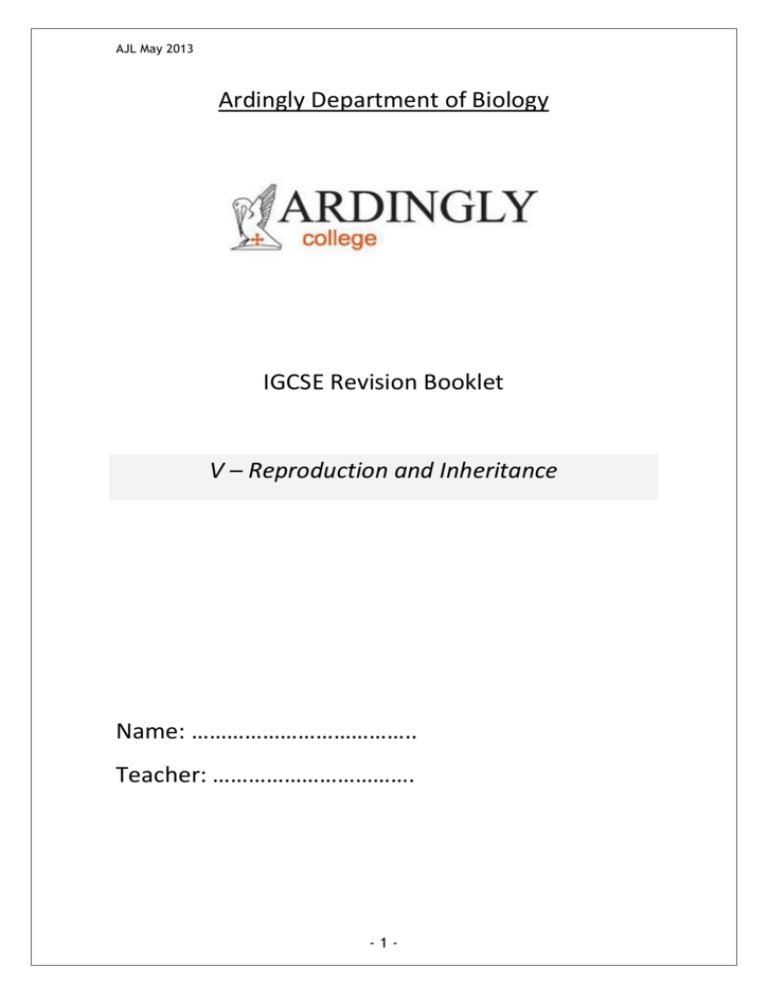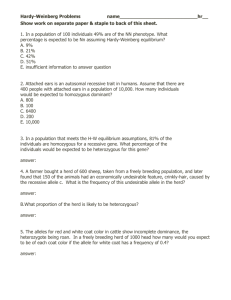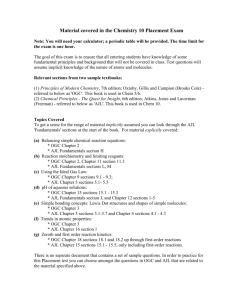BIOLOGICAL MOLECULES
advertisement

AJL May 2013 Ardingly Department of Biology IGCSE Revision Booklet V – Reproduction and Inheritance Name: ……………………………….. Teacher: ……………………………. -1- AJL May 2013 Introduction Reproduction can be split into two divisions: .................................... and sexual. ...........................................: Involves just one parent. Does not lead to genetic variation Examples include: ....................................... and ................................... Sexual: Involves .......................... parents and .................................. genetic variation Examples include: ......................................... and .............................................. Involves the fusion of two ............................ to produce a zygote (the process of .................................). Plant reproduction Label the diagrams below of an insect and wind pollinated flower: Insect: Wind: Adapations: Adapations: ........................................................... ........................................................... ........................................................... ........................................................... ........................................................... ........................................................... ........................................................... ........................................................... ........................................................... ........................................................... Advantages Advantages ........................................................... ........................................................... ........................................................... ........................................................... ........................................................... ........................................................... ........................................................... ........................................................... ........................................................... ........................................................... -2- AJL May 2013 After pollination (transfer of pollen from anther to stigma): It is necessary for the nucleus from the male gamete (the pollen) to meet and fuse with nucleus from the female gamete (the ovum) To do this the pollen grows a pollen ........................which grows down the stigma and style and finds the ovum The male nucleus travels down this tube and ......................... the ovum. The fertilised ovule forms the ......................... The ovary wall often thickens and produces sugars to become the......................... The seed will remain dormant until conditions become suitable for ......................... Such conditions include: 1. ................................................................................... 2. ................................................................................... 3. ................................................................................... During this process the embryo will develop a root (or radicle) and then a shoot (plumule). Before the young plant can photosynthesise it will rely on the .......................................... to provide the energy needed. Asexual reproduction in plants It is possible for plants to reproduce asexually (i.e. without flowers or fertilisation). Two of the most important methods of asexual reproduction are: ................................- e.g. strawberry, spider plant ................................- e.g. potatoes, dahlias -3- AJL May 2013 Human reproduction Sperm are produced in the testes under the influence of several hormones, including .............................. They pass along the sperm duct, combining with fluid from the ............................... vesicle before being ........................................... Sperm are produced continuously in the male from ........................... However, in the female all the immature eggs are already produced by birth. From puberty until the ....................... the female releases (usually) one egg in a process known as ............................... This is part of the .......................... day ............................ cycle which is under the influence of several hormones. Label -4- AJL May 2013 the hormones on the following diagram. Fill in the following table Hormone Site of production Function Pituitary gland Involved in ovulation and the production of the ‘corpus luteum’ Ovary Maintain lining of uterus (..................................) Fertilisation: If a sperm and egg do meet the resulting .............................. then undergoes a series of cell .............................. before it implants in the wall of the uterus, which is now referred to as a ............................... After several days the structure is called an ..............................which in turn develops into a foetus. During development the foetus is provided with nutrients from the mothers blood supply via the ..............................This structure allows very close contact between the foetuses and mothers circulations, although the two do not mix. In the space below list 4 substances which may exchange between the two (remember to think it is a two-way process): 1. .............................................................................. 2. .............................................................................. 3. .............................................................................. 4. .............................................................................. In addition to being provided with nutrients the developing foetus is also protected by a sac which contains .......................................... fluid. Secondary sexual characteristics. These develop at the time of puberty and caused by the release of .................................... in males and .......................................... in females. Give some examples below: Males: Females: 1. ............................................................................ 1. ............................................................................ 2. ............................................................................ 2. ............................................................................ 3. ............................................................................ 3. ............................................................................ 4. ............................................................................ 4. ............................................................................ -5- AJL May 2013 Inheritance. The genetic material in cells is made of the molecule ..................................... In human cells it is located in the ....................................., where it comprises ..............................pairs of ................................... each of which contains many sections which are known as genes. Each _________ consists of alternative forms called ..................................which cause differences in inherited characteristics. Define each of the following terms to do with genes: Dominant: .................................................................................................................................................................... .................................................................................................................................................................... Recessive: .................................................................................................................................................................... .................................................................................................................................................................... Homozygous: .................................................................................................................................................................... .................................................................................................................................................................... Heterozygous: .................................................................................................................................................................... .................................................................................................................................................................... Phenotype: .................................................................................................................................................................... .................................................................................................................................................................... Genotype: .................................................................................................................................................................... .................................................................................................................................................................... Co-dominance (also give an example): .................................................................................................................................................................... .................................................................................................................................................................... -6- AJL May 2013 Complete the following diagram of a monohybrid (a single characteristic) cross: homozygous pea plants with spherical seeds were crossed with homozygous plants with dented seeds. (Spherical seeds are the dominant characteristic.) The seeds were collected and allow to grow into the first generation (F1). These were allowed to self-pollinate to form a second generation (F2). Parental phenotype: x Parental genotype: x Parental gametes: Punnet square (F1 genotypes): F1 phenotypes: x F1 genotypes: x F1 gametes: Punnet square (F2 genotypes): F2 phenotypes (give ratio): Complete a similar diagram below to show the chance of having a boy or girl is 50:50 In humans one of the best ways to interpret the inheritance of genetic characteristics is by using a pedigree chart. If, for example, the chart shows that the child of two healthy parents has a genetic disease where they have to be homozygous recessive, it shows that the parents must both have a ......................................... genotype. Human inheritance is best studied using a pedigree chart. An example is seen below. In this chart the coloured squares/circles represent a particular trait e.g. a disease. Such charts are good as they show if a condition is more likely in a particular ................. or whether it is ...................................... or ............................................ -7- AJL May 2013 Cell division To reproduce cells must divide. Therefore the nucleus and all the DNA must also divide. Nuclei can divide by either mitosis or meiosis. Mitosis is used during, growth, repair, cloning and ..................................reproduction and results in two ..................................... cells to the parent. Complete the following diagram of a cell containing two chromosomes (a ...................................number of two) as it goes through mitosis: Prophase & Meiosis differs from this in that it produces ......................... cells with half the amount of genetic material (haploid). Each cell is also genetically ................................. This process is used in the production of ......................... for sexual reproduction. In humans the .......................... number is 46, whereas the ............................number is 23. Meiosis promotes ........................... in a species. However, the original differences in the DNA of a species is caused by ................................ This leads to genetic variation, of course the ............................................... also promotes variation Mutations are .......................and random changes in the DNA which can be passed on. They can be ..................................., neutral (i.e. cause no apparent effect, or even ................................. The incidence of mutation is increased by exposure to: .................................................................................................................................................................... .................................................................................................................................................................... Mutant organisms can increase in number by the process of .......................... selection. This works simply by: 1. All species show variation 2. All species produce ........................... offspring than can survive to adulthood. 3. Therefore there is ............................ for resources. 4. Only those best ......................................... to their environment will survive. 5. These will pass on their ................................ to the next generation. 6. This characteristic will therefore increase in number with time. -8- AJL May 2013 An example of this, in bacteria, is: .................................................................................................................................................................... .................................................................................................................................................................... .................................................................................................................................................................... .................................................................................................................................................................... .................................................................................................................................................................... .................................................................................................................................................................... IGCSE Questions 1. (a) Cells can divide by mitosis. The diagram below shows the chromosomes in a parent cell before mitosis takes place. (i) Complete the diagram to show the chromosomes in each daughter cell. (ii) What is the diploid number of the parent cell? ................................................................................................................................................................(1) (b) The graph below shows the time taken for cells to divide by mitosis at different temperatures. -9- AJL May 2013 (i) How does the increase in temperature affect the time taken for cell division to occur? ............................................................................................................................................................(1) (ii) Starting with one cell, at 25 °C, how many cells would there be after 2 hours ................................................................................................................................................... 8 hours ................................................................................................................................................(2) Total 5 marks 2. The diagram shows a section through a flower. (a) Name the parts labelled A, B, C and D. A ............................................................................................................................................................. B ............................................................................................................................................................. C .............................................................................................................................................................. D .............................................................................................................................................................. (4) - 10 - AJL May 2013 (b) Part E produces pollen. In some flowers the pollen grains contain starch. The gene for making starch in the pollen grains has two alleles. The allele B for making starch is dominant and the allele b is recessive. Some pollen grains were collected from one flower and tested to see if they contained starch. The diagram below shows the results seen using a light microscope. (i) Name the substance used to test for starch. ................................................................................................................................................................(1) (ii) If the pollen grains contain starch, what colour will they be after this test? ................................................................................................................................................................(1) (c) Pollen grains are haploid, so contain only one allele for a character. Look at the diagram in (b) showing the pollen grains. (i) What is the genotype of the flower that produced these pollen grains? Tick the correct answer. (ii) Pollen is collected from a flower that is homozygous recessive and tested for starch. Which of the following shows the results you would expect to see? Tick the box under the correct answer. Total 8 Marks - 11 - AJL May 2013 3. Cystic fibrosis is an inherited condition. The allele for cystic fibrosis is recessive. The condition develops when a person is homozygous recessive. (a) How many copies of the allele need to be present for someone to have cystic fibrosis? ...........................................................................................................................................................(1) (b) The letter N is used for the normal allele, and the letter n is used for the allele for cystic fibrosis. A mother and father both have the genotype Nn and do not have cystic fibrosis. In the space below, complete the genetic diagram to show the genotypes of the gametes of the mother and father and the possible genotypes of their children. You should also state which of the children would develop cystic fibrosis. (c) Scientists can test people to find out if they carry the allele n. The test is done on genetic material from inside cells. (i) Which part of a cell contains genetic material? ...............................................................................................................................................................(1) (ii) Name the molecule that genetic material is made from. ................................................................................................................................................................(1) Total 6 marks 4. Clover is a small plant that is often eaten by snails. Scientists have found two types of clover plant growing on a mountain. They differ in their ability to make a poisonous substance called cyanide. The clover plants that grow at the bottom of the mountain can produce cyanide. They have alleles that make their cells produce small bags of an enzyme in the cytoplasm. If a snail starts to eat the plant the bags are broken and the enzyme is released. The enzyme produces cyanide and so the snails stop eating the clover. The clover plants that grow at the top of the mountain cannot make cyanide. Their cells have different alleles and do not produce small bags of enzyme. If they did, ice crystals that sometimes - 12 - AJL May 2013 appear in the cytoplasm would burst the bags and kill the plants. It is too cold for snails to survive at the top of the mountain. (a) Explain why clover plants that make cyanide are found growing at the bottom of the mountain and not at the top of the mountain. Use your understanding of natural selection in your answer. .................................................................................................................................................................... .................................................................................................................................................................... .................................................................................................................................................................... .................................................................................................................................................................... .................................................................................................................................................................... .................................................................................................................................................................... .................................................................................................................................................................... ................................................................................................................................................................(5) (b) All clover plants have swellings called nodules on their roots. These nodules contain nitrogen fixing bacteria. These are one type of bacteria that play an important part in the nitrogen cycle. The table shows events that occur in the nitrogen cycle. Complete the table by naming the type of bacteria involved with each event. Total 9 marks 5. The diagram shows how the levels of oestrogen and progesterone vary in the menstrual cycle. (a) On the diagram, show how the line for progesterone would change if the woman became pregnant. (1) (b) Fill in the missing words in the sentences below. - 13 - AJL May 2013 The fusion of a male and female gamete is known as fertilisation, which produces a single cell called a ......................................... This cell divides and develops into an ........................................, which is protected by ........................................ fluid in the uterus. (3) (c) Which type of reproduction involves gametes? ...............................................................................................................................................................(1) Total 5 marks 6. Huntington’s disease is a genetic condition that affects the nervous system. Huntington’s disease is caused by a dominant allele, H. The condition does not develop until middle age (around 40 years old). (a) A couple plan to have children. The father is heterozygous for Huntington’s disease and the mother is homozygous recessive. (i) Draw a genetic diagram to show the genotypes of the parents, the gametes and the possible genotypes and phenotypes of their children. Use H to represent the allele for Huntington’s disease and h to represent the normal allele. (4) (ii) What is the probability of this couple producing a child who will not develop the disease? ...............................................................................................................................................................(1) (b) The symptoms of the disease do not appear until middle age. Suggest why this makes it unlikely that Huntington’s disease will disappear from the population. .................................................................................................................................................................... .................................................................................................................................................................. (2) - 14 - AJL May 2013 (c) Huntington’s disease affects the brain. The brain is part of the central nervous system. (i) Name the other part of the central nervous system. ................................................................................................................................................................(1) (ii) Some reflex actions, such as withdrawal of a finger from a hot object, do not involve the brain. Explain how a reflex arc helps in the withdrawal of a finger from a hot object. .................................................................................................................................................................... ................................................................................................................................................................... ................................................................................................................................................................... ................................................................................................................................................................... .................................................................................................................................................................... ................................................................................................................................................................(5) Total 13 marks - 15 -






